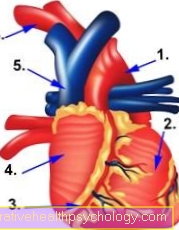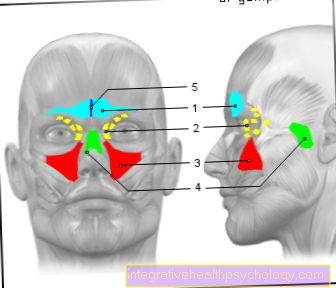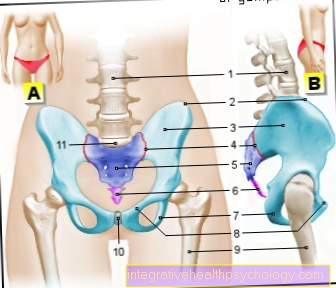The eye muscle paralysis
introduction
Eye muscle paralysis is also known in ophthalmology as ophthalmoplegia or eye muscle paresis. This is an eye disease that paralyzes the eye muscles.
Paralysis of the eye muscles is understood to be a restriction of movement in one or both eyes, which is caused by damage to the eye muscle, the point of transmission between muscle and nerve, the supplying cranial nerves or the brain. Depending on where the damage is located, vertical, horizontal or torsional strabismus can occur. Since the squint (strabismus inconcomittans or strabismus paralyticus) occurs from one moment to the other, double vision occurs.
The eye muscles are made up of small muscles located on the outer eye and are used to move the eyeball. In the case of eye muscle paralysis, one or more of these muscles lose their function due to various causes and, as a result, the movement of the eye is restricted.

What types of eye muscle paralysis are there?
There are two forms:
- the complete eye muscle paralysis (paralysis), very rare
- the eye muscle weakness or incomplete paralysis (Paresis)
Recognizing eye muscle paralysis
What are the symptoms of eye muscle paralysis?
The eye muscles ensure that the both eyes are coordinated in their movements and placed in parallel. In the case of paralysis of individual or all eye muscles, this can no longer be done and therefore those affected see double vision and squint. As a result, patients have problems grasping and coordinating, typically bumping into objects while walking. Patients try to compensate for the squint by tilting their head to the sound side. A blurred image can also be an indication of eye muscle paralysis.
Other symptoms that can occur with eye muscle paralysis depend on the cause of the disease. Inflammation in the brain can lead to fever, headache, fatigue or nausea. The same applies to infectious diseases or poisoning. Sudden speech disorders, walking problems or one-sided paralysis are signs of a stroke and must be treated medically as soon as possible. In addition to eye muscle paralysis, tumors in the brain can also trigger fever, impaired consciousness and changes in personality.
The double vision
Double vision is known as diplopia in medical terminology and can be triggered by various diseases.In the context of eye muscle paralysis, diplopia is caused by a shift in the visual axis. The objects that you see are no longer projected in the right place on the retina. The brain cannot process the information correctly due to the incorrect projection. The result is double vision which leads to blurred vision. Headache and dizziness can also occur.
The therapy for double vision depends on the underlying disease
How is eye muscle paralysis diagnosed?
If you see double vision or other signs of eye muscle paralysis that have not resolved within a few hours, those affected should see an ophthalmologist immediately. An emergency doctor must be called immediately if there are accompanying symptoms such as paralysis or language problems that make you think of a stroke.
The doctor first asks a few questions about the symptoms and accompanying symptoms, which allows him to collect a detailed medical history of the patient. Then the eye examination takes place. Another step is electromyography (EMG) of the eye muscles, which can be used to detect paralysis. For some questions, it may be necessary to have an MRI image of the brain. Additional blood tests provide information about possible inflammatory processes or the presence of an infection.
Find out more about the topics here: EMG & MRI
Treating eye muscle paralysis
How is eye muscle paralysis treated?
In any case, a detailed neurological examination, an ENT examination and a radiological evaluation must be carried out before therapy is initiated. In the therapy of eye muscle paralysis, the treatment of the underlying disease is in the foreground and is therefore individually different in each case. Since eye muscle paralysis can heal spontaneously, surgery is usually not attempted until about a year after the paralysis occurs.
Before that, an attempt is made to find the causes of the paralysis. Above all, ruling out a brain disease is important so that targeted therapy can then be started.
Depending on the cause, anti-inflammatory drugs are given, tumors removed if possible, muscles may need to be shortened to compensate for a squint. Frosted glass can also be worn in front of the eye to minimize the annoying double images or prisms can be used to compensate. The acute symptoms caused by eye muscle paralysis can be treated by an ophthalmologist. The patient has to put on so-called prism glasses against the double vision. These are glasses that are covered with a special prism film. This compensates for the double images and the patient can see clearly again. There is also the option of masking one eye to make the double vision disappear.
If the paralysis of the eye muscles is caused by inflammation in the brain (e.g. MS), treatment is carried out with the administration of cortisone. Bacterial infections of the head area can usually be treated well with antibiotic drugs. Surgical treatment may be necessary for brain tumors that press on nerves or severe head injuries. In any case, eye muscle paralysis must be clarified by an ophthalmologist and possibly also neurologically or internistically in order to quickly find out the cause and initiate appropriate treatment.
Find out more about the topic here: The anti-inflammatories.
How can you train the eye muscle?
In principle, the eye muscles are built like any other muscle in the body and can therefore be trained in a targeted manner. In the case of visual disturbances that can be traced back to weakness or paralysis of the eye muscles (for example, squinting or double vision), training helps to improve the symptoms.
An object, e.g. a ballpoint pen or an eraser, fixed in front of the face at eye level with one eye and slowly moved in different directions. The other eye is covered. The distance between the object and the face should be around 30-40 cm.
The aim of the training is to follow the object with your eyes and not move your head if possible. The head should not be moved, as this would relieve the eye muscles and the training effect would be lost.
Preventing eye muscle paralysis
What are the causes of eye muscle paralysis?
Eye muscle paralysis can be the result of numerous disorders and diseases. If the cranial nerves that supply the muscles are damaged, the result is paralysis of the respective muscle. The damage can be due to an injury to the head, inflammation in the brain, or cerebral circulation disorders (stroke).
Another cause of eye muscle paralysis is diseases of the eye muscles themselves, such as muscle inflammation. Inflammation of the eye muscles often occurs as part of an overactive thyroid (hyperthyroidism): the patients then suffer from severely swollen eye muscles that can no longer be moved and the eyes bulge out (exopthalmus) .
Eye muscle paralysis can also occur with bleeding in the brain, poisoning, tumor diseases or infectious diseases. Of course, injuries directly to the eye can lead to paralysis of the eye muscles and disturbances in eye movements. Temporary paralysis of the eye muscles can also be alarm signals as they can herald a stroke.
And, due to this,
- damage to one or more nerves that belong to the eye muscle (3rd, 4th or 6th cranial nerve)
- a nerve-to-muscle signal transmission disorder,
- a muscle disorder
The signs of a stroke? Find out more about this here.
Can eye muscle paralysis be triggered by stress?
One cause of eye muscle paralysis can be stress. Fatigue or persistent internal tension also promote the development of eye muscle palsy.
Constant stress can lead to overexertion of the eye muscles. The muscles can no longer work synchronously and the complex interaction of the eyeballs during the visual process is eliminated. Those affected begin to squint and see double vision. This is a harmless trigger and with appropriate countermeasures an improvement occurs quickly. Nevertheless, eye muscle paralysis as a result of excessive stress is a clear warning sign of the body and should be taken seriously by those affected.
Measures that reduce stress and relax include, for example, autogenic training and progressive muscle relaxation. Both techniques can be easily performed at home using video instructions and have proven effective in coping with stress. But also simple habits such as regular sport, mindfulness in everyday life, enough punch and a varied, healthy diet contribute to mental well-being and reduce stress.
That might be interesting for you too: How can you reduce stress?
Course of an eye muscle paralysis
What is the duration of eye muscle paralysis?
The duration of eye muscle paralysis depends on the cause. The symptoms of failure do not necessarily have to last forever. In some cases, the disease can heal spontaneously after a few weeks or months, for example after a circulatory disorder in the brain. Eye muscle paralysis can also become chronic.
Can eye muscle paralysis be cured?
Whether or not eye muscle paralysis can be cured depends on the underlying disease that triggers it. If this can be treated well, the eye muscle paralysis usually goes away too. Especially if the paralysis is caused by psychological stress, there are good chances of recovery with appropriate treatment.
Further questions of eye muscle paralysis
What are the effects of eye muscle paralysis after a stroke?
The occurrence of eye muscle paralysis can be caused by a stroke (Apoplexy) caused. As a result of a circulatory disorder in the brain, there is an undersupply of certain areas and failure symptoms.
Classic symptoms of a stroke are sudden onset of speech disorders, hemiplegia and dizziness. If the circulatory disorder affects areas that are responsible for the supply of the eye muscles, eye muscle paralysis and double vision occur.
The elderly are more likely to have a stroke and the symptoms of failure are often concentrated in one eye. A stroke is an absolute emergency where every minute counts. If a stroke is suspected, those affected need immediate medical help, otherwise serious damage to the brain can occur.
You might also be interested in:
- Stroke therapy
- Stroke in the eye
How does eye muscle paralysis affect MS?
Particularly in young people, eye muscle paralysis can also be a more serious disease such as multiple sclerosis (MS). Multiple sclerosis is an autoimmune disease that causes inflammation in the central nervous system (i.e. the brain and spinal cord). The disease often manifests itself at the beginning in the form of vision problems such as visual field defects or eye muscle paralysis.
In MS, incorrect programming of the immune system leads to the destruction of the myelin sheaths around nerve cells, inflammation foci develop and the function of the nerve tissue is restricted. If the inflammation affects the nerves that supply the eye muscles, eye muscle paralysis occurs. Typically, both eyes are affected by the symptoms.
Learn more at:
- Optic nerve inflammation in MS
- Course of Multiple Sclerosis
How does eye muscle paralysis affect neuroborreliosis?
Eye muscle paralysis can occur as a side effect of neuroborreliosis. This leads to an infection of the central nervous system with Borrelia. Borrelia are bacteria that are usually transmitted through a tick bite.
The pathogens multiply and after a few weeks cause problems in the nervous system. Pain, meningitis or facial paralysis may occur. Due to a dysfunction of the cranial nerves, the eye muscles are often affected by the symptoms of paralysis. Accompanying symptoms are also stiff neck and fever.
Neuroborreliosis should be treated immediately with appropriate medication, as otherwise there may be a progressive deterioration in the state of health.
You can also find out more at: Lyme disease - you should know that!





























